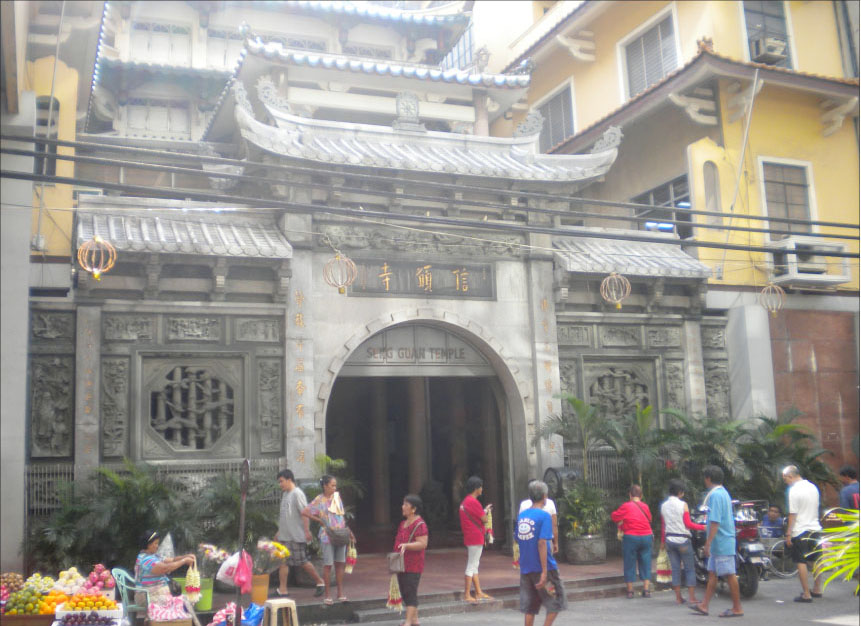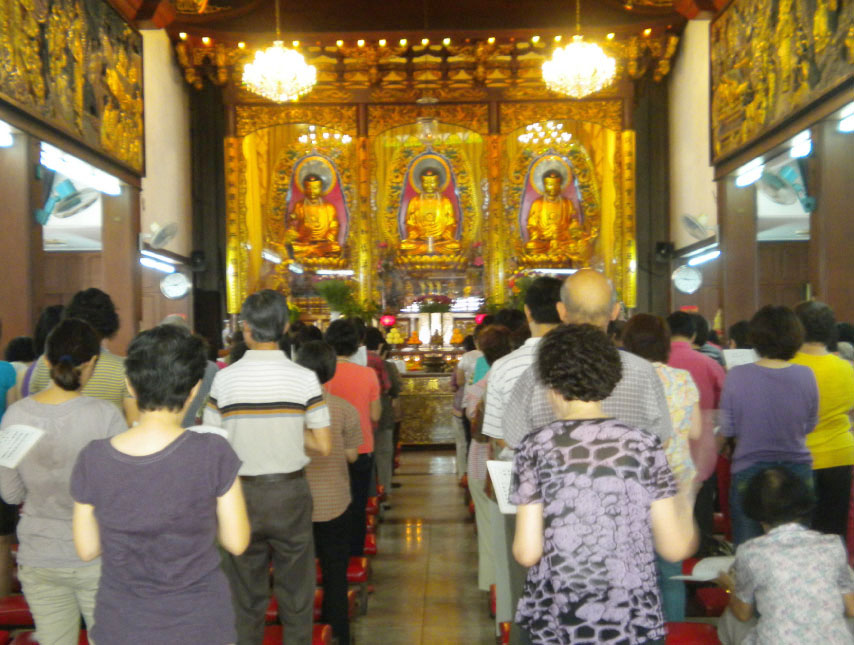Editors Note: This is the 18th of a series about the 36 Chinese Buddhist temples of the Philippines. Much of the information is from a thesis of Venerable Chuanmiao (Hsuan Chuang University, 2008), a Buddhist monk affiliated with the Thousand Buddha Temple in Quezon City.
18. Seng Guan Temple (信願寺)
1176 Narra Street, Tondo, Manila | Tel.: 252-0792
In 1931, Wu Jiangliu (吳江流) founded the Guanyin Tong (觀音堂), and offered his family shrine for common worship around the image of Guanyin. He later invited others to form the Chinese-Buddhist Society in the Philippines and purchased land on Narra Street for a new a temple. It was built in 1936, and Xingyuan (性願) was invited to come from Xiamen’s Nanputuo (南普陀寺) temple the following year to be the first abbot.
Being the first temple to have a resident monastic, Seng Guan is considered the first Buddhist temple in the Philippines, and Xingyuan the initiator of Chinese Buddhism in the country, although it must be noted that the temple’s groundwork came entirely from lay believers.
The temple survived the war, but not a fire in 1949 that gutted the temple’s wooden buildings. The large statues of the buddhas and bodhisattvas were not damaged by the fire, and this was considered miraculous by the devotees, who then spent the next two years building a sturdier concrete structure.
More buildings were put up in succeeding years, by which time Xingyuan had invited several more monks from Xiamen to join him in Manila.
Xingyuan was abbot until 1948, when he asked Ruijin (瑞今) to take over as abbot and he concentrated on building the Hwa Chong Temple in Malabon. Ruijin was responsible for much of the temple’s building expansions.
In 1958, eminent monk Yinshun (印順) was visiting from Taiwan. Xingyuan invited him to be abbot of both Seng Guan and Hwa Chong temples. Yinshun served in this capacity for two years. The abbotship returned to Xingyuan in 1960 until his death in 1962.
Ruijin was abbot of both temples from 1962-1974, and again from 1986-1990. From 1990-2005, he was abbot of only Seng Guan, as the two temples began to have separate abbots.
The abbot from 1974-1986 was Hongchuan (宏船), originally from Fujian but serving in Singapore when he was called. He served the maximum continuous term of 12 years. Since 2005, Chuanyin (傳印), a nephew of Ruijin, has been abbot.
While the succession of abbots provides a sense of how leadership has been passed on, it must also be noted that abbots often had to attend to temples in Taiwan, Fujian or Singapore as well.
Other monks and lay associations were stable presences at Seng Guan and kept regular activities going.

Main buildings. Located in a dense part of Tondo near Chinatown, the Seng Guan Temple is a complex of three buildings supplemented by an annex building connected to the temple by a bridge on the second floor.
The central building has two worship halls. The bodhisattvas Guanyin, flanked by Manjusri and Samanthabhadra, are enshrined on the ground floor, where large numbers of devotees come to carry out private devotions and many aspects of popular religion are practiced. On the second floor is the shrine to the three Buddhas, where chanting services are held.
The building on the right has the kitchen and dining room, a special chapel to the Thousand Hands Thousand Eyes Guanyin, an air-conditioned multi-purpose hall, and monastics’ living quarters.
The building on the left is the main ancestral hall where Ksitigarbha is also enshrined. The upper floor is a large, high-ceilinged, air-conditioned hall where a large statue of the Medicine Buddha is enshrined. The roof of this building is a stupa – a monument – with 10,000 small images of Buddha.
The annex building has a carpark, more ancestral halls, including an indoor stupa with the remains of Ruijin, a library and meditation hall, classrooms and dormitories.

Leadership and primary activities. Around 10 monks are normally resident in the temple. The numbers are fluid because some monks stay briefly before moving to other temples. The abbot, Chuanyin, is also in charge of temples in Fujian and divides his time between the two places. The temple has an active board of directors and lay associations that manage many of its activities.
Monastics organize the weekly Sunday morning one-hour chanting service and the longer services to mark all Buddhist feast days.
Since this temple is the oldest one with a monastic community, it is conventionally considered the headquarters of Chinese Buddhism in the Philippines and other temples try not to compete with its schedule of services.
On the lunar new year’s eve, the temple is open all night for the thousands of devotees who come to light their first incense for the year. Several hundred devotees attend the major services during the new year, feasts of Guanyin, and the Yulanben festival for the dead during the seventh lunar month.
Two lay associations organize weekly activities. The Seng Guan Buddhist Society (佛學社) runs a Sunday school for children and teenagers divided into three age groups, teaching Buddhism and Chinese culture using Hokkien Chinese as the medium of instruction. The Society also carries out charitable activities several times a year.
The Meditation Group (靜修班) has a two-hour session every Sunday afternoon that combines sitting and walking meditation with a short lecture. Once a year, when the country goes on Holy Week holidays, the group organizes a four-day retreat at the temple.
The senior and learned monk Zhengzhong (正宗), based in Taiwan, is the inspiration behind this group. He has published several books and CDs of his talks from a radio show he produced in the 1980s. — First published in Tulay Fortnightly, Chinese-Filipino Digest 25, no. 22 (April 23-May 6, 2013): 8-9.